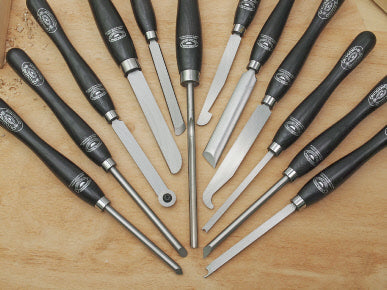
Crown Cryogenically Treated Woodturning Tools
There has been a lot of excitement around the Cryogenic treatment of woodworking tools over the past few years. In this article, I hopefully will be able to demystify things a little bit and help you to decide whether Cryogenically treated tools are really worth all the hype.

The Crown Tools Range of Cryogenically Treated Woodturning Tools from the UK
Let me firstly say that Cryogenically treating metals is not new.
The Cryogenic treatment of metals and alloys has been extensively applied in various industries to improve wear resistance of the materials since the mid 1960s.
Basically the process works like this: The treatment generally subjects the metal to temperatures below -280º F (-174º Celsius) and quite often below -300º F (-184º Celsius) for between 20 and 60 hours.
This Dry Cryogenic process is precision controlled and the materials to be treated are not directly exposed to any cryogenic liquids such as nitrogen. Overall, all the treated materials retain their size and shape.
Cryogenically treated materials generally show improved hardness, toughness, stability, corrosion resistance and reduced friction.
Some materials have shown little or no improvement after a Cryogenic treatment. However, High Speed Steels (HSS) and Tungsten Carbide have shown improved tool life in the woodworking industry after Cryogenic treatment.
This is good news for woodworkers and woodturners in particular.

High-temperature corrosion and oxidation has been shown to be a major contributor to the wear of Tungsten Carbide when machining Medium Density Fiberboard (MDF). However, deep Cryogenic treatment showed increased tool cutting edge life in this application.. Cryogenic treatment has been very successfully applied to die steels and high speed steels (HSS) and by all accounts lengthens the cutting edge life of Tungsten Carbide.
Interestingly, one manufacturer of Titanium Alloy parts reported that, after treating the M-42 twist drills it uses, the company needed 63% fewer of the tools to do the same work. In another instance, a 400% improvement in tool durability was achieved using cryogenically treated C-2 Carbide inserts to mill 4340 Stainless Steel.
So how on earth does it work?
It is all about "Slow Cooling"! Slowly cooling a tool steel to Cryogenic temperatures and "soaking" it for several hours changes the material's microstructure. Almost all of the Austenite (a soft form of iron) retained in the steel after heat treating is transformed into the much harder form of Martensite by deep Cryogenic tempering.
A second result of a deep Cryogenic "soak" is the formation of fine Carbide particles, called binders, to complement the larger Carbide particles present before Cryogenic treatment.
One study by the Louisiana Polytechnic Institute, looked at how the changes brought about by Cryogenic treatment affected steel's ability to resist abrasive wear. (This is the part that is important to us woodworkers).
The study found that the Martensite and fine Carbide formed by deep Cryogenic treatment work together to reduce wear.
The Cryogenic process enhances the conversion from one phase (Austenite) to another phase (Martensite), which is a common change in ferrous metals as a result of heat treating and now, Cryogenic treating.
Cryogenically tested Tungsten Carbide was tested in a wood machining turning test with MDF to demonstrate that a Cryogenic treatment enhance edge retention and therefore tool life.
So, what does this mean to us at the woodworking coalface (or tree bark)?
It appears that Cryogenically treated woodworking chisels such as woodturning tools should have a longer edge retention life, therefore lengthening the time of effective cutting use between sharpenings. This is not because Cryogenically treated steel is harder (mostly it isn't), but because much more of the steel is converted from the Austenite phase into the Martensite phase.
In my book, this can only be a good thing, as I detest having to frequently sharpen and hone as I am turning a workpiece. It detracts my concentration from the design at hand.
Recently, I purchased a Crown cryogenically treated oval skew woodturning chisel. I wanted to try it out on one of my current projects which involves turning eight legs for Black Cherry bedside cabinets.
Although my test is by no means scientific, I have turned all eight legs with this chisel without re-honing or sharpening and it is still cutting crisply!
I am extremely happy with the results and I will shortly invest in a Crown Cryogenically Treated Spindle Gouge and Roughing Gouge as well.

Comments
Leave a comment